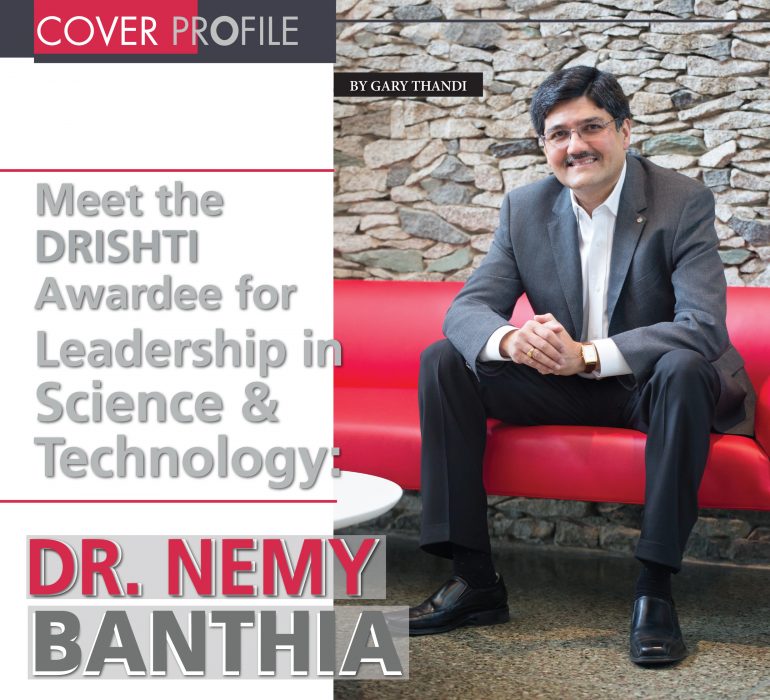Meet the DRISHTI Award for Leadership in Science and Technology: Dr. Nemy Banthia
Prime Minister Justin Trudeau, both pre, and post his election, has spoken at great lengths about his plan to spend nationwide on infrastructure projects, because it is needed and it is essential to stimulate the Canadian economy. However, not only building new infrastructures is the most crucial need. Repair, rehabilitation, and strengthening of structures already in place throughout Canada are also of immediate importance. The collapse of the Concorde Overpass in Montreal clearly indicated that many structures such as bridges, roads, and publicly-run buildings in Canada are in dire need of repairs or strengthening. The Federation of Canadian Municipalities estimates that major Canadian cities face an infrastructure deficit of $123 billion for such restoration projects. Citizens demand that such repair solutions should not only be cost-effective and long-lasting but also to be environmentally-sound.
A professional engineer who obtained his Ph.D. from the University of British Columbia in 1987, Dr. Nemy Banthia is at the forefront of initiatives to address infrastructure challenges both in Canada and internationally. Before his Ph.D., his studies were completed in India.
“At the Indian Institute of Technology in Delhi where I graduated from, almost my entire class went to the United States,” he recalls. “I was a bit of a non-conformist, so I came to Canada, and chose UBC. “Then it dawned on me that Canada is indeed such a beautiful country, and people are so kind; the opportunities are endless.”
Dr. Banthia’s primary research interest are in fiber reinforced concrete repair and strengthening, structural health monitoring, smart materials, non-destructive condition assessment, and low carbon footprint construction materials. The rest of us take for granted the various structures we encounter on a daily basis. Using them without necessarily worrying about how strong they are structurally or whether they are environmentally sound, Dr. Banthia is often busy studying, assessing, and repairing these structures to ensure that they remain safe and have a little environmental impact.
Dr. Banthia describes himself as a civil or structural engineer, noting that the field of “engineering is very broad, and Civil Engineering is the oldest form.”
Civil engineering encompasses building, bridges, roads, power plants, and water and waste-water treatment facilities. “I specialize on the strengthening side, of bringing the capacity of a structure up.”
He compares engineers to scientists like geologists and chemists—noting that “researchers will develop new materials and new concepts, and an engineer will apply them to the real world.” As an example of such applied work, he may be asked to consider the capacity of a bridge, to determine for example, “if a 30-tonne truck could go over the bridge? Obviously, if it cannot, then it is a hazard and poses a real safety concern. So, with advanced analytical tools, we assess its safety. If found deficient, we would devise ways to strengthening the bridge, so it can safely handle that 30-tonne truck.”
Dr. Banthia not only assesses structures for their performance in everyday use, but he also considers their seismic capacity. So just because a structure may handle daily use, it may not necessarily have been built to withstand a seismic event like an earthquake.
He further studies and develops materials that may be used to strengthen or build structures. He notes that concrete is used in major construction project around the world and that it is a major pollutant and contributes to overall carbon dioxide emissions. He has developed a series of advanced environmentally safer material that can reduce the carbon footprint of structures by over 80%. One of his inventions, Sprayed Fiber Reinforced Polymers are being used worldwide for seismic strengthening. Another involves the use of nanotubes for producing smart materials that communicate with engineers over the Internet. Dr. Banthia holds five patents, published over four hundred refereed papers, edited 20 volumes, and serves on the Editorial Boards of eight top international journals. Additional distinctions include recognition as a Distinguished University Scholar (UBC) in 2003; elected Fellow of Canadian Academy of Engineering in 2004; selected by Business in BC Magazine as One of British Columbia’s Top 25 Innovators in 2004; elected Fellow of the Canadian Society for Civil Engineering in 2006; elected Fellow of the Royal Society of Canada in 2011; and he currently holds a Senior Canada Research Chair in Infrastructure Rehabilitation and Sustainability. He also serves on the technical committees of various professional societies, including the American Concrete Institute where he chairs the Committee on fiber reinforced concrete, RILEM (Réunion Internationale des Laboratoires et Experts des Matériaux) where he chairs the Technical Committee on FRP (fiber reinforced polymer)-Concrete Bond; and the Canadian Standards Association; where he chairs the Durability Committee of the Highway Bridge Design Code.
As a youth, Dr. Banthia was always interested in infrastructure and how it impacted community. “Growing up in India,” he recalls, “it was apparent to me how poor the state of infrastructure was. I could see the poor quality of housing, poor quality of water, and the little state of transportation infrastructure. That kind of reinforcement always interested me because that’s how you can transform societies and create healthy communities and vibrant economies. It has always been my motivating belief that we can make communities prosperous and efficient by creating proper infrastructure.”
Dr. Banthia is also the Scientific Director and Chief Executive Officer of the Canada-India
Research Centre of Excellence (IC-IMPACTS). The Centre, which is supported by both Indian and Canadian Governments, has as its ultimate goal to increase the safety and sustainability of critical civil infrastructure, bring clean drinking water to communities and provide affordable healthcare. The Government of India recently invited IC-IMPACTS to help clean the river Ganga. Dr. Banthia’s involvement is not only in developing improved techniques for treating industrial effluents from textiles, tanneries and pulp and paper industries by the banks of Ganga but also in making these processes affordable and sustainable. Dr. Banthia explains: “civil engineers will do hydrological modeling, on the computer, where they will input rainfall data, and will look at the flow of river … if there are contaminants, they will look at how and what distance they will travel, and when and if they will become biodegradable.” Dr. Banthia is proud to be leading such initiatives, which will benefit the overall health of Indians on the sub-continent. He advises “guilt I had as an immigrant was that I was trained in India, but I did not contribute to my country of origin. I emigrated and instead contributed to Canada. I now have the opportunity to give back.” He notes that he also supervises many students from India, who will return to their home country and can contribute with the knowledge they gained here.
All of Dr. Banthia’s accomplishment have not gone unnoticed. He is the recipient of numerous awards such as the Wason Medal of American Concrete Institute, Solutions Through Research Award of the BC Innovation Council, Wolfson Merit Award of the Royal Society of the UK, Killam Research Prize from the Killam Foundation, Horst Leipholz Medal of the Canadian Society for Civil Engineering, and Mufti Medal of Excellence of the International Society for Health Monitoring of Infrastructure (ISHMII). Recently added to his many achievements is the 2015 DRISHTI Award for Leadership in Science and Technology. “It was a great evening,” Dr. Banthia notes of the gala event, “and I enjoyed meeting the other award recipients.”
In addition to his research and applied work, Dr. Banthia is a full-time professor at the University of British Columbia and teaches both undergraduate and post-graduate classes. While undoubtedly busy, he has so many responsibilities; he still finds time to volunteer at a local hospital once per week. He also swims and plays Squash whenever he can free up some time.
When asked what type of advice he can give to youth considering a career in engineering, Dr. Banthia recommends that one should “expose yourself to as many experiences as you can. I have come across a youth who say they want to be an engineer but don’t quite know what that means. Or a young person will say they want to be a CEO but don’t know what that means. Youth today have so many options to learn about various subjects. They can go online, search all the different options available for careers. They can attend various talks or lectures. And they can volunteer, and learn about different careers that way.” Dr. Banthia has also observed a trend that he wishes to see change. “I’m a very proud Indian, who loves being here. One thing I’ve noticed is that our Indian youth is not coming to universities in the proportion of their population. It is increasing, but there is much more that can be done. I would love to see more of our youth enrolling in higher education. I think we need to teach our young people to strive for something much bigger.”
Congratulations Dr. Banthia on your many accomplishments, and we are proud at DRISHTI Magazine to recognize you with a DRISHTI Award for your Leadership in Science and Technology.



